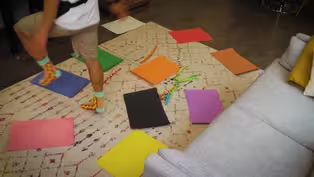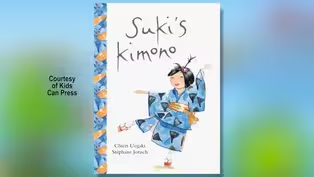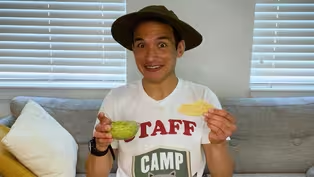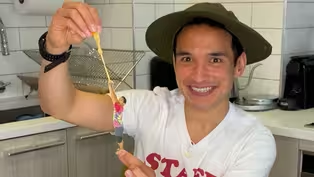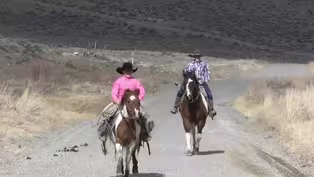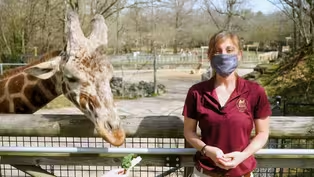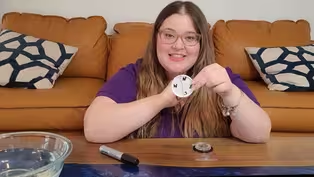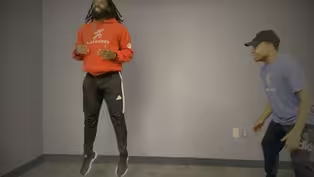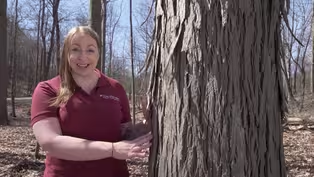
Travel Day (Long Version)
7/2/2021 | 56m 56sVideo has Closed Captions
Try foods from different countries, play “Land, Sea, Air,” make a compass!
Join head counselor Zach and try food from different countries, play “Land, Sea, Air,” make a compass. Meet giraffes and cowboy kids, go on a sensory hike, read SUKI’s KIMONO, do a pattern dance! Content partners include Buffalo Bill Center of the West, Carnegie Hall, Liberty Science Center, Memphis Zoo, OK Go, Playworks, Seneca Park Zoo.
Problems playing video? | Closed Captioning Feedback
Problems playing video? | Closed Captioning Feedback
Camp TV is a local public television program presented by THIRTEEN PBS

Travel Day (Long Version)
7/2/2021 | 56m 56sVideo has Closed Captions
Join head counselor Zach and try food from different countries, play “Land, Sea, Air,” make a compass. Meet giraffes and cowboy kids, go on a sensory hike, read SUKI’s KIMONO, do a pattern dance! Content partners include Buffalo Bill Center of the West, Carnegie Hall, Liberty Science Center, Memphis Zoo, OK Go, Playworks, Seneca Park Zoo.
Problems playing video? | Closed Captioning Feedback
How to Watch Camp TV
Camp TV is available to stream on pbs.org and the free PBS App, available on iPhone, Apple TV, Android TV, Android smartphones, Amazon Fire TV, Amazon Fire Tablet, Roku, Samsung Smart TV, and Vizio.
Providing Support for PBS.org
Learn Moreabout PBS online sponsorship[cheerful music] - Hi, everybody, my name is Zach and welcome to "Camp TV".
Are you ready for some summer fun?
Me, too!
[laughing] Now, as your head counselor I will be introducing you to all sorts of cool activities.
Arts, crafts, games, math and science as well as some of my favorite books, nature and theater.
I will be here to take you from one activity to the next so follow me on "Camp TV"!
[cheerful music] - [Announcer] This program was made possible in part by the Corporation for Public Broadcasting, a private corporation funded by the American people.
Additional funding was provided by The Peter G. Peterson and Joan Ganz Cooney Fund and the Pine Tree Foundation of New York.
[ukulele strumming music] ♪ Camp TV ♪ ♪ It's time for us to start ♪ ♪ From furry animal encounters ♪ ♪ To summer reading and the arts ♪ ♪ No matter what the weather ♪ ♪ We'll explore it all together ♪ ♪ It's a place for you and me ♪ ♪ It's Camp TV ♪ [cheerful music] Hello "Camp TV" adventurers!
Just finished up a hike at the Grand Canyon.
What views!
Next up, I'm thinking a visit to Rome to see the Colosseum [classical operatic music] although I hear Costa Rica's pretty great this time of year.
[bird calling] Then again, how could I resist seeing the Egyptian pyramids [Middle Eastern music] and if I'm already on that side of the world, well, maybe I'll just pop into India to visit the Taj Mahal.
[traditional Indian music] Come to think of it, [water rushing] I've always wanted to visit Niagara Falls, too.
Ah, there are just so many incredible places to visit, [cheerful music] so many fascinating people to meet, how is a head counselor to choose?
Well, there's no need [plane engine humming] because today is Travel Day on "Camp TV".
Up first, a trip to today's first activity, have fun!
[upbeat music] A little birdie told me it's time to Go Wild!
- Hi, everyone and welcome to the Memphis Zoo here in beautiful Memphis, Tennessee.
My name is Nikki and I am joined by my friend Niklas here and we are here to learn all about what makes giraffes special, the important jobs they have and how animals need us just as much as we need them.
That's a pretty tall tale if you ask me so let's go, let's learn more about giraffes.
[thoughtful music] Giraffes are unique animals that live in the grasslands or savannas of Africa.
Their only cousin is another unusual animal called an okapi.
There are four species of giraffe that are different in coat color and home range.
The Memphis Zoo is home to a type called the reticulated giraffe.
Did you know that every giraffe has a unique spot pattern just like human fingerprints?
Now even though there are four different types of giraffes they all share similar adaptations and are equally important to the savannas they call home.
Giraffes are the tallest mammal in the world, coming in up to 18 feet tall, as tall as a two story building!
Even newborn babies are taller then most humans.
There long necks look like they have a ton of bones but believe it or not they have the same number in their neck as we do, seven!
A human vertebra is pretty small but a giraffes neck bone is about as long as our forearm.
That neck helps these herbivores, or plant eaters, reach the highest branches of the tallest trees.
This means they get plenty of food without competing with smaller herbivores.
Their height also helps their other animal neighbors.
Often, several species of animal will congregate to eat and drink and sun.
Giraffes serve as the lookout for danger as they are usually the first to spot a predator approaching.
That lets all the other herd animals know to beware.
Giraffes in the wild particularly enjoy the leaves of the acacia tree.
These are trees that have long, thorny branches that are hard for most animals to enjoy.
Giraffes don't mind, though.
Their long tongue and prehensile lips help to pull the leaves off without getting hurt.
Giraffe tongues are about 18 inches long and are rough like a cats tongue but also slobbery like a dogs tongue and they're purple!
Can you guess why?
Since their tongue is exposed to the sun so much while eating the purple color kind of acts like built in sunscreen.
All this eating makes giraffes the gardeners of the savanna.
By eating all those plants they prune the trees, cutting them back which encourages new growth.
Giraffes also clear out the canopy, making more room for sunlit that helps smaller plants grow, feeding the smaller herbivores.
Believe it or not, their poop is important, too!
When they eat the seeds of the acacia trees, those seeds pass through the giraffe and come out the other side in a nice little fertilizer packet.
Some acacia seeds can only germinate or start to grow after they pass through a giraffe, that's really important.
Without giraffes the savanna would be a much different place.
By helping their natural community, giraffes help humans, too.
Humans also live and work on the savannas and benefit from it's health.
Unfortunately, giraffes are disappearing.
They're already gone from seven countries where they once lived.
Their number one threat is habitat loss.
That means that humans are using more and more and leaving less and less of the places that giraffes live.
Here at the zoo all our giraffes were born in human care and help us make new giraffe families so that there will always be a healthy population.
Our latest addition is Ja Raffe who was born to Niklas and Angela Kate just last year.
With all of their unique adaptations and the important jobs that they have, giraffes are really an animal that we can look up to.
So, Niklas, myself and all of us here at the Memphis Zoo hope you go spread the word so that your friends and families can love and help giraffes, too.
Bye, friends!
[cheerful music] - [Zach] Music, dance, magic and more, step right up to Center Stage.
- Ola, musical explorers, [accordion music] I am Gregorio, this is my friend Jonathan, we're very excited that we're gonna be teaching you about Cumbia for Colombia.
The song that we're gonna work with today is called "El Pescador" which means "The Fisherman" and this is a very special fisherman because he talks to the moon and he talks to the beach.
So we're gonna start with the pronunciation of the words.
So, the first word that you need to know is "el pescador".
The next part is "Habla con la luna".
The next part, "Habla con la playa".
"No tiene fortuna".
And then the next part we have to really roll our R's, I'm sure you can do that.
It goes like this, "Solo su atarraya".
Okay, so now we're gonna get ready to learn the melody and it's a call-and-response so we're gonna start by learning the call.
So, you're gonna repeat after me.
Here we go.
♪ El pescador ♪ [singing in Spanish] ♪ El pescador ♪ ♪ El pescador ♪ ♪ El pescador ♪ ♪ El pesca-do-oh-oh-or ♪ ♪ El pesca-do-oh-oh-or ♪ - Now we're gonna get ready to learn the response so repeat after me.
♪ Habla con la luna ♪ [singing in Spanish] ♪ Habla con la luna ♪ ♪ Habla con la playa ♪ ♪ Habla con la playa ♪ ♪ No tiene fortuna ♪ ♪ No tiene fortuna ♪ ♪ Solo su atarraya ♪ ♪ Solo su atarraya ♪ Now we're gonna put both parts together and I want you to choose whichever part you wanna sing.
Jonathan is gonna be doing the call and I'm gonna be doing the response.
Here we go!
One, two, one, two, three!
[Cumbia music] [singing in Spanish] ♪ El pescador ♪ ♪ Habla con la luna ♪ ♪ El pescador ♪ ♪ Habla con la playa ♪ ♪ El pescador ♪ ♪ No tiene fortuna ♪ ♪ Oh-oh-oh ♪ ♪ Solo su atarraya ♪ ♪ El pescador ♪ ♪ Habla con la luna ♪ ♪ El pescador ♪ ♪ Habla con la playa ♪ ♪ El pescador ♪ ♪ No tiene fortuna ♪ ♪ Oh-oh-oh ♪ ♪ Solo su atarraya ♪ [maracas rattling] [accordion music] Yeah, Jonny!
- Nice!
[hands slapping] Now that you've learned the song I wanna teach you about the instruments and the rhythms so I'm gonna start with the accordion and the accordion has the keys and it also has the bellows and it sounds like this.
[energetic accordion music] Now we're gonna move on the the percussion and the first one is gonna be the tambora and it sounds like this.
A one, two, three, four.
[drumsticks tapping] [drum thumping] [drumsticks tapping] [drum thumping] [drumsticks tapping] [drum thumping] [drumsticks tapping] [drum thumping] Now, we're gonna move on to the llamador and this instrument is the heartbeat of Cumbia and it sounds like this.
One, two, three, four!
[drum beating] Finally, we're gonna add some maracas.
So, the maraca sounds like this.
One, two, three, four!
[maracas rattling] And now I wanna put 'em all together but I'm gonna take off my accordion so that I can join in with Jonathan and play some percussion.
So, here it is all together!
[drum beating] [rhythmic percussion music] All right, so now we're gonna get ready to play the song and I want you to sing with me in the chorus and during the verse I want you to choose any of the rhythms that you learned and you can play them along.
Here we go!
One, two, three, hah!
[Cumbia music] ♪ Regresan los pescadores ♪ [singing in Spanish] ♪ Con su carga pa' vender ♪ ♪ Al puerto de sus amores ♪ ♪ Donde tienen su quere ♪ ♪ Regresan los pescadores ♪ ♪ Con su carga pa vender ♪ ♪ Al puerto de sus amores ♪ ♪ Donde tienen su quere ♪ ♪ El pescador ♪ ♪ Habla con la luna ♪ ♪ El pescador ♪ ♪ Habla con la playa ♪ ♪ El pescador ♪ ♪ No tiene fortuna ♪ ♪ Oh-oh-oh ♪ ♪ Solo su atarraya ♪ ♪ El pescador ♪ ♪ Habla con la luna ♪ ♪ El pescador ♪ ♪ Habla con la playa ♪ ♪ El pescador ♪ ♪ No tiene fortuna ♪ ♪ Oh-oh-oh ♪ ♪ Solo su atarraya ♪ [Cumbia music] Adios, everybody!
[Cumbia music] I hope you really enjoyed the song and that you keep singing it!
- Welcome back!
[upbeat island music] Now, while you were off enjoying your last activity I took a wrong turn and somehow ended up in Hawaii!
Now, I bet you're thinking, "Wow, nice Zach!
Is the weather warm?
Have you gone surfing yet?"
Well, the short answer is no.
Somehow, I've landed at the base of a volcano.
And no, again, [volcano rumbling] I have no idea how this has happened.
Gulp!
So, who's ready for a [inhaling] Zach Challenge!
Now, I must insist, do not try this at home, especially on your own.
You must ask an adult for permission, preferably one that owns the furniture and remembers doing this exact same game when they were little.
Maybe they'll give you a pass but if not, leave the leaping to me!
My goal is to get from here to there and back in under ten seconds and I can only use the stepping stones.
If I touch the ground, or lava, the game is over.
Okay, here goes nothing!
[countdown beeping] Go!
[clock ticking] [suspenseful music] Oo, oo, hee!
Ah, hee!
Uh, uh, ah!
[Timer buzzing] Yes, nailed it!
No lava feet for me.
[laughing] [volcano rumbling] Okay, but this place is making me kinda nervous so I'm gonna get outta here.
I think you better head off, too.
Okay, see you soon, bye!
[volcano rumbling] Oo!
Hot, hot, hot-hot-hot, hot, hot!
[cheerful music] Curiosity and wonder, let's discover together.
It's Science Wow!
[scene whooshing] [upbeat music] - Smells, sounds, [swan honking] sights, feels!
I sense something fun coming up.
As humans we five senses, sight, smell, taste, hearing and touch.
Our senses send information about our surroundings to our brain and usually that information has a purpose.
Think about it, if you smell smoke you know there's a fire nearby.
If you hear the rattle of a rattlesnake [snake rattling] you immediately know to back up and give her space.
Interacting with nature is a great way to test your senses and that's what we're gonna be doing today.
Let's go!
But wait, [soundtrack slowing] we're going to leave taste out of this experience.
Some plants and bugs use toxins to defend themselves from predators, you should never put anything in your mouth without the supervision of an experienced guide.
All right, let's go!
[upbeat music] We're in upstate New York and as you can see a lot of our trees lose their leaves in the winter time.
[woodpecker rapping] Did you hear that?
That sounds like a woodpecker.
These birds use their extra tough beaks to drill holes in the sides of trees to get to the bugs that live underneath the bark.
You can see their holes high up in trees and they're typically more active in the mornings.
I'm sure we'll be hearing more from him on the rest of our hike, let's keep going.
Nature smells so good.
I'm smelling the budding plants of spring.
I'm smelling decaying leaves and that nice, rich soil smell and, you know, it's a really sunny day today.
I wonder if the sun has a smell?
Well, plants use the sun for photosynthesis, giving off oxygen in the process.
So, I must be smelling nice, fresh oxygen.
How cool!
[upbeat music] [footsteps crunching] [water gurgling] Do you know what this is?
It's moss and it is so soft.
Moss is a plant that uses the sun for energy but instead of sucking up water through roots it drinks through it's leaves which is what makes it so soft to the touch.
This is a shagbark hickory.
Look at how rough and flaky the bark is!
And this tree has bark that is so smooth.
Isn't it cool how trees in the same area can be so different?
It's a little later in the day now and we're further up the trail from where we started.
Let's take a minute to stop and listen to the forest around us.
[leaves rustling] [water gurgling] [birds whistling] [geese honking] [squirrel rustling] I'm always amazed at how much more is going on around me then I realize.
Whenever I'm on a hike I like to take a moment to just remind myself how active and alive nature is.
I hope you will, too.
[upbeat music] This is Trout Lake.
It's home to a wide variety of species, bodies of water typically are.
Let's see what we can find in this new ecosystem.
[birds chirping] [geese honking] [blackbird trilling] Hey, look, there are two mallard ducks behind me.
If you can only see one, that's the point.
Female ducks are camouflaged, that helps them stay hidden from predators while they're raising their young.
[upbeat music] Check this out!
These are wild chives.
Chives are a type of onion so I'm sure you can imagine how they smell.
[inhaling] Mm, I love the smell of chives but some insects don't.
That's how this plant protects itself from being eaten by bugs.
That's all the time we have for today.
I hope you learned some fun, new ways to use your senses the next time you are outside.
Remember to question why something smells the way it does or why it looks a certain way.
You might learn something new and the answer might surprise you.
Thanks for joining me today and good luck on your future explorations.
[cheerful music] - [Zach] Ready for some math that counts?
Count On!
- Hi, everyone, my name's Norah and I'm gonna show you one of my favorite math games to play at home.
We're gonna do a pattern dance.
To play this game you just need yourself and a friend to play with you.
You can either play together in the same space or you can play over a video.
In this game you and your friend are going to choreograph a dance using patterns.
A pattern is anything that repeats in the same order over and over again.
So, for instance, in art and fashion we see repeating shapes and colors.
In music we hear repeating notes and other sounds and in math we see repeating numbers.
In this game we're gonna have repeating patterns that we make with our body in our dance moves.
Check it out!
[upbeat music] Here's how it works.
First I'm gonna choose a dance move, maybe a kick like this and then I pick a number.
How about three?
So the first part of our dance pattern is three kicks.
One, two, three!
[drum beating] Now my friend is gonna come up with another dance move and another number.
Let's say they choose two twirls.
One!
[magical chiming] Two!
[magical chiming] Okay, it's my turn for another move.
Let's do a chicken peck five times.
One, two, three, four, five!
[chicken squawking] Take turns going back and forth at least two more times with your friend to add more moves to your pattern.
Then it's time to put the whole thing to the test.
Turn on your favorite song and do your entire dance from the beginning together.
Once you finish your pattern one time, repeat it as many times as it takes to get through the whole song.
Hmm, let's add a couple more moves to this dance pattern.
[spring boinging] [slide whistle music] [horn honking] [bell dinging] Okay, let's try the whole thing from the top.
Ready?
Here we go!
[upbeat music] [drum beating] [magical chiming] [chicken squawking] [spring boinging] [slide whistle music] [horn honking] [bell dinging] Now let's repeat our pattern!
[drum beating] [magical chiming] [chicken squawking] [spring boinging] [slide whistle music] [horn honking] [bell dinging] Yay!
Whew, I'm really wiped out from all that dancing.
You can make your own pattern dance at home, too.
This is also a great game to play over a video chat with a friend or a family member.
Well, I hope you enjoyed watching all my crazy dance moves.
See you next time.
Bye!
[cheerful music] - [Zach] Who is ready for a Field Trip!
[country western music] - So, the main important job of being a cowboy is mostly caring for the livestock that you take care of and make sure they have enough water and, hi, enough water and food.
- [Chauncey] Probably the most important thing on the ranch to do is to move cows so they enough water and food every once in a while and make sure, like, animals that you're taking care of have enough and if, like, a cow or a calf or a bull gets hurt by a grizzly bear or a wolf that you get it taken care of.
- Okay, so the hat that we wear is to protect us from sun, rain and snow getting on us and we also wear a scarf or sometimes cowboys call it a wild rag, it's to protect us from getting sunburned on our necks and we wear pants to protect us from sagebrush hitting us and we wear boots so we can slip our feet in and out of of the stirrups pretty easy and we use spurs to nudge the horses to get on 'em go or to make 'em turn one way or another.
- We got chaps which come in different types that you put your leg through them and then you tighten it with a buckle that helps you from cactus and sagebrush when you're riding so it doesn't scrap your leg or make holes in your pants and they keep you warm.
I got my first saddle when I was two and then my Mom and Dad just led me around then when I was four I started riding horses all by myself.
- It was for the same as me, we, me and Chauncey both have our own.
I have one that's named JJ I'm just starting.
- [Chauncey] And I have three.
One of them is Boomerang and then the other one's Smore 'cause he looks like one and then the third one which is a she, I named her Buttercup and I don't know why.
[country western music] And that's how you saddle a horse.
- In summertime we would usually wake up early to go with our Dad to move the cows.
Why we wake up that early is because they move easier when it's colder and not as hot.
[country western music] The favorite part of cowboying for me is mostly getting to start new horses and go out with my Dad but he, on this ranch we got to.
- [Chauncey] And the most things I like the most is saving a calf's life right as it's born and starting new horses and making sure all the cows are safe and good.
[country western music] - Welcome back to Travel Day on "Camp TV".
You know, you don't always have to hop on a plane, train or automobile to travel somewhere new.
Adventure can be found all around us.
You can explore new worlds right in your own backyard.
Have you ever lifted a rock and discovered a colony of bugs or found nature in an unexpected place?
Like, a plant growing out of a crack in the sidewalk.
Or, how about looking around your community?
I happen to live in a place where there are all sorts of people from all sorts of places from around the world and with that comes lots of interesting neighborhoods to visit.
Just walking around them can make you feel like you're somewhere else.
One of my favorite ways to explore new culture is through my stomach.
I love dumplings from Chinatown, cannolis from Little Italy and Korean fried chicken from Koreatown.
Mm, yummy!
Are you not able to experience the world outside your window right now?
Then bring the outside in!
There are all sorts of yummy recipes you can try.
Homemade guacamole from Mexico, pasta from Italy or meatballs from Sweden.
There are all sorts of ways to travel without ever leaving your home, you just need to know where to look and listen.
Don't mind if I do!
[chip crunching] [upbeat music] Curiosity and wonder, let's discover together.
It's Science Wow!
[upbeat music] - Hey, Andy.
- [Andy] Hey.
- What do you see here?
- It looks like a bunch of pool noodles hanging in the air.
- Okay, go check it out from over there.
- [Andy] Oh, it's a cube.
- Isn't that cool?
- [Andy] Yeah.
- These pool noodles, you can look at them from anywhere and see pool noodles but from one specific spot you're brain also tricks you into seeing a cube even though there's no cube here.
- [Andy] Cool, how does it work?
- Well, it's all about perception and perspective.
Look, I'll show you, let's go make a little one in a box.
- [Andy] Okay.
- Okay, so we're gonna build the same thing in this little box.
What we need is a ruler and some paper, pencils, pens, something like that.
Uh, fishing line, yeah.
- Hmm.
Something to cut with, scissors or a blade.
Tape, clear tape, gotta be clear, could be packing tape, scotch tape.
Pipe cleaners and a thumb tack.
What you're gonna do is cut a hole along the bottom of the box that's like an inch and a half square.
- So, right in the middle?
- [Damian] Right in the middle.
- On the bottom?
- Yeah, and I'm gonna draw the cube we wanna make 'cause it's gonna go on the other side of the box.
Okay?
- Okay.
[upbeat music] So you cut that hole, that's where we're gonna be looking through to see the cube- - Like this?
- Yeah, right.
- You can but you're eyes gonna be close so you're gonna cover it with tape, this is like the glass through which you are seeing- - Oh.
- So cover it on both sides so it's not sticky.
Like, sticky side in and sticky side out.
- Okay.
[upbeat music] - Oh, that's good.
You like my cube?
- Beautiful.
- [Damian] So, this is gonna go on the back wall.
- Okay.
- So, I'm gonna tape it on the back wall just using, again, you know, clear tape, whatever.
It's gonna come, we're gonna pull this off later so I don't want it to be too stuck down.
- Perfect.
- So, your window, can you see my cube through the window?
- [Andy] Yes.
- The next thing we're gonna do, we're gonna poke holes through each of the corners of the cube.
- Okay.
[upbeat music] - [Damian] So we got all eight of 'em?
- [Andy] Yep.
- All right, so, see the cube there?
- Yes.
- You wanna put your eye like, basically you want to hold it perfectly still and you're gonna poke holes in the same eight corners.
- So, the corners of the square, in the cube in the back?
- Right, 'cause this is where you're like lining it up.
So, you see those same places where you just poked back here?
- Okay.
- You're now poking through this but you're eye has to stay steady- - Right.
- So, if it moves around a little bit- - Yeah, I should be, yeah, I should keep in the same position I have.
- Right, you might want, for instance, to put this down, like lock it against the table.
Now, if it moves a little bit that's fine as long as you line up the holes you already poked.
Does that make sense?
- Yes.
[tense music] - Your holes are perfectly lined up, Andy, that's really good.
So now, we can take my picture out, right?
- Okay, we take that out.
- It's out, it's gone- - Oh, and you can, okay.
- Now you just have holes here which are like the little version of the holes here.
We're gonna run this string, this fishing line through from this hole to the equivalent hole on the front.
- Okay.
- Okay, we're gonna feed it through and we're gonna feed it through the one up here.
I'm gonna use the packing tape to fix it here- - Okay.
- 'cause you want like the strongest tape you have for this part.
Doesn't need to be clear at this point because we're not gonna look through it.
- Right.
- But what you do need is for this to be tight and we're gonna need, what?
Eight of those, right?
- Eight, yeah.
[upbeat music] All right, we've got our fishing lines laid out and now we're gonna draw the actual thing using pipe cleaners.
So, this, I've cut a whole bunch of different lengths and you're gonna connect the lines that we see this through that window.
- I see, okay.
- All right, so those top two strings, find where this pipe cleaner can lay across them, bend it around the edges.
- [Andy] So, it's kinda like a couple inches off the back.
- [Damian] Yeah.
- [Andy] Um, okay.
I think that's a pretty good top line.
- Okay, check it out.
Now I'm gonna give you one much shorter.
- Okay, okay.
- So, you're gonna have to connect lines that are much closer to the front.
- I see.
- Right?
[upbeat music] So now if you look through it you see how you've got the top and the bottom?
That's this line and this line in the cube- - Right.
- So now by eye we're gonna go and put all the rest of them in and it's important that you use ones of different lengths and put them at different places in the box this way- - Mm-hm.
- Because you wanna have them spread out throughout the whole box.
- Right.
[upbeat music] - Yeah, dead on.
- Cool.
Look at the cube, dude.
- [Andy] Oh, yeah!
Looks like a cube.
- Look at that!
- Nicely done.
[hands slapping] - So, I mean, from this angle what have we got?
- Yeah.
- We got nothing, we got, we got, these are pipe cleaners- - Yeah.
Look at 'em, sort of like our pool noodles- - Exactly.
- But from ba-ba-boom, there!
- [Andy] Cube.
- It's a cube!
- It's a good cube.
[upbeat music] [cheerful music] - [Zach] It's time to get active.
Let's Move!
- I'm Coach Henry.
- I'm Coach Zok.
- [Both] Let's play!
- All right, today we're gonna play a game called "Land, Sea, Air".
What is it called?
- "Land, Sea, Air".
- Great, and in this game there are three commands.
The commands are "land", "sea" and "air".
But before we can start we're gonna take our magic fingers and we're gonna draw an imaginary line in front of us so make sure you're looking at your imaginary line because in this game the commands are gonna tell you where to jump.
So, if I say "land" you're gonna stand behind you're imaginary line, right?
When I say "sea" you're gonna hop over that line and get in front of it and when I say "air" you're just gonna jump straight up.
[feet thumping] All right, so everybody back on land.
Great.
Now let's see how well we can do this.
This is just a demo round.
Ready?
Land!
All most got him.
[Zok laughing] Sea!
[feet thumping] Air!
[feet thumping] Land!
[feet thumping] Great job.
So, now that everyone has an understanding of how to play the game we're gonna play together so make sure you're matching me.
Ready?
[upbeat music] Sea!
[feet thumping] Air!
[feet thumping] Air!
[feet thumping] Land!
[feet thumping] Sea!
[feet thumping] Land!
[feet thumping] Air!
[feet thumping] Air!
[feet thumping] Great job.
Now, we're gonna incorporate some jumping jacks so anytime we do an incorrect movement we're gonna do two jumping jacks and jumping jacks are just like this.
One, two!
Okay, everyone understand?
Great, so let's give it a try now.
Ready?
Air!
[feet thumping] Land!
Oh, almost got him.
Sea!
[feet thumping] Air!
[feet thumping] Aw, messed up.
Ready?
One, two!
[feet thumping] All right, now I'm gonna play without moving so let's see if I can get Coach Zok and if I can get all of you at home.
Here we go!
Ready?
Air!
[feet thumping] Sea!
[feet thumping] Sea!
Oh, saw a flinch but we're gonna say he's good.
Land!
[feet thumping] Air!
[feet thumping] Air!
[feet thumping] Air!
[feet thumping] Air!
[feet thumping] Land!
[feet thumping] Ah, got him.
[hands clapping] That's two jumping jacks.
- [Both] One, two.
[feet thumping] - Great.
I think you boys and girls are getting this so now I'm gonna add another command.
This command's gonna be called "helicopter".
Anytime I say "helicopter" we're gonna put our hands together and we're gonna turn around in a circle.
All right?
So let's give it a try.
Ready?
Helicopter!
Okay, so let's put it all together.
Ready?
Sea!
[feet thumping] Land!
[feet thumping] Helicopter!
Air!
[feet thumping] Sea!
[feet thumping] Land!
[feet thumping] Air!
[feet thumping] Air!
[feet thumping] Helicopter!
Great job!
Now I'm gonna try and play one more time by watching Coach Zok and watching you all.
Here we go.
Ready?
Sea!
[feet thumping] Land!
[feet thumping] Helicopter!
Air!
[feet thumping] Air!
[feet thumping] You know what, you boys and girls are really good.
I'm gonna have Coach Zok announcing the game.
Here we go!
- Land!
Air!
[feet thumping] Air!
[feet thumping] Sea!
[feet thumping] Land!
[feet thumping] Air!
[feet thumping] - Ah-ah!
- All right!
One, two.
[feet thumping] One more.
- Land!
Air!
[feet thumping] Air!
[feet thumping] Air!
[feet thumping] Sea!
[feet thumping] Sea!
Land!
[feet thumping] Air!
[feet thumping] Air!
[feet thumping] Sea!
[feet thumping] Land!
[feet thumping] Air!
[feet thumping] Helicopter!
- Whew!
Helicopter!
- Man!
[panting] Coach, that was a good job!
Round of applause for yourselves, [hands clapping] round of applause for yourselves.
Well, I hope you had fun today playing "Land, Sea, Air" and in true Playworks fashion we're gonna end with a clap.
This clap is gonna be called "The Helicopter Clap".
When I count to three we're all going to clap and we're gonna do a helicopter and say, "Whew, I'm tired!"
Ready?
One, two, three.
[hands clapping] Helicopter.
- Helicopter.
- [Both] Whew, I'm tired!
- Have a great day and can't wait to see you soon!
[quiet music] - Have you ever had a friend or family member go on a trip without you?
Do you wish you could join someone on an upcoming trip but can't?
Well, here's a way to be part of the fun anyway.
It's time to make a tiny trekker you.
For this bookmark you will need a fun photo of yourself, more on that in a second, some scissors, a hole punch, some ribbon or a tassel and some clear carton sealing tape.
Begin by posing [camera clicking] as though you're swinging from a rope or floating away, just make sure your arms are above your head and your hands form a fist.
[camera clicking] Once you have a pose you love for this bookmark, print it out.
Next, put down a long piece of carton sealing tape.
Place your photo in the middle and carefully fold the tape over your photo.
Then slowly walk your fingers down the piece to get all of the air out.
Next, carefully cut yourself out.
Oo, almost cut my hair off.
[quiet music] All right.
When you're done use a hole punch at your hands.
For the final step take a piece of ribbon or a tassel and put it through the hole like this.
And there you have it, a tiny trekker you!
Now they'll never have an excuse to leave you home again.
[cheerful music] Curiosity and wonder, let's discover together.
It's Science Wow!
- Hmm.
I wonder where it could be?
Ah!
Found it!
Hi, my name is Jenn from Liberty Science Center and I was just searching for my compass.
I left it at home by accident but I really could have used it earlier today when I was out hiking in the park.
I knew that I parked my car in the East parking lot, I just didn't know which way East was!
A compass, which is a tool that helps us tell direction, would have been super helpful to have.
Hey, have you ever used a compass before?
The red part of a compass needle always points North.
Now, if we know where North is we also know where South, East and West are, too.
Pretty cool, right?
What's even cooler is that you can make your own compass at home using everyday materials.
To make a compass you'll need a magnet, a paper clip, a bowl filled with water, a styrofoam cup, scissors, tape and a permanent marker.
First, careful cut off the bottom of your cup and place it aside, we'll need it in a little bit.
Next, grab your paper clip and this might be a good place to ask an adult for help because you're just going to carefully unfold and straighten your paper clip until it looks a bit like a needle.
Now, don't worry too much about it being perfectly straight.
This next step is super important.
You wanna grab your magnet and your paper clip needle and just rub your magnet against one side of the paper clip needle.
Now you wanna make sure that you're always going in the same direction, never back and forth and that's why you'll notice that every time I return to the starting point I lift my magnet up before pressing it back down.
Now you want to continue this for about 30 seconds or 50 strokes.
48, 49, and 50!
Okay.
Now take your paperclip needle and the bottom of the styrofoam cup that you cut before and just put your needle right in the middle of it.
Now take a piece of tape and attach your needle to the styrofoam cup bottom so that it looks like this.
Finally, take your completed homemade compass and float it in your bowl of water.
Now watch it do what a compass does best.
So you'll see it start to rotate just like mine is doing and then when it starts to settle and finally stops you'll know that you're compass has found North.
The easiest way to figure out which end of your homemade compass points North is to use another compass.
Now, you can use a compass like this one or you can use a compass app on your phone.
Okay, so by comparing my compasses I can tell that this end of my homemade compass is pointing North and I know that because that's the direction that the red part of this compass needle is also pointing.
Now this is a really great way for me to confirm that my homemade compass is working correctly.
Now that you know which end of your homemade compass points North you can label it with a permanent marker so you'll know for next time and remember, if you know which direction North is, you also know where South, East and West are and if need a little help figuring that out, you can always take a look at your second compass.
It's awesome to see our compass in action but how does it work?
The answer is magnetism.
[magnets clicking] If you've ever explored magnets before you know that they can push each other apart or pull each other together [magnets clicking] depending on how they're positioned.
Well, guess what?
Earth is like one giant magnet!
It creates it's own magnetic field with North and South poles.
Now by rubbing a magnet against our paper clip we also turned the paper clip into a magnet!
Floating it on the water allowed it to freely interact with Earth's magnetic field and find magnetic North.
You're homemade compass will only stay magnetized for a little while so if you'd like to use it again, simply rub your magnet on your paper clip needle and place it in the water.
You'll easily be able to tell which direction is North since you've already labeled it.
Well, now that I've got my compass I'm headed back outside.
Thanks for joining me, scientists, bye for now!
[cheerful music] - [Zach] Daytime or nighttime, it's always time for Story Time.
Oh, hey!
You're back and just in time, I was about to read a new book, "Suki's Kimono".
Wanna read it with me?
Great!
"Suki's Kimono" written by Chieri Uegaki and illustrated by Stephane Jorisch.
[quiet music] "On the first day of school Suki wanted to wear her kimono.
Her sisters did not approve.
"You can't wear that," said Mari.
"People will think you're weird."
"you can't wear that," said Yumi.
"Everyone will laugh and no one will play with you.
You need something new, Suki, you need something cool."
But Suki shook her head.
She didn't care for new, she didn't care for cool.
She wanted to wear her favorite thing and her favorite thing was her kimono.
Suki's obachan had given her the kimono.
The first time Suki wore it, her obachan took her to a street festival where they slurped bowls of slippery, cold somen noodles and shared a cone of crunchy shaved ice topped with a sweet red bean sauce.
Under strings of paper lanterns Suki joined her obachan in a circle dance.
She followed her and copied her movements, trying to be as light and as graceful.
She watched the other women and children who danced, especially those who were dressed in cotton kimonos like her.
[drums beating] Later, Suki sat so close to the stage that when the taiko drummers performed, bom-bom-bom-bom, she felt like she'd swallowed a ball of thunder and her whole insides quaked and quivered.
Before they left the festival Suki and her obachan stopped at the souvenir stand.
There were many things to chose from but her obachan found the prettiest thing of all, a handkerchief of pale pink linen decorated with tiny maple leaves and cherry blossoms.
When she gave it to Suki she said, "This will help you remember our day."
Now it was time for school.
Mother checked Suki's obi one last time and took a picture of Mari, Yumi and Suki together by the front steps.
Then, as she watched, the three sisters made their way down the block to their school.
Mari and Yumi stayed several paces ahead of Suki and pretended they didn't know her but Suki didn't mind.
She turned and waved to her mother before she clip-clopped along in her shiny, red geta, feeling very pleased in her fan patterned, blue kimono.
Once in a while Suki would lift her arms and let the butterfly sleeves flutter in the breeze.
It made her feel she'd grown her own set of wings.
When they reached the school Mari and Yumi hurried across the yard to a group of their friends.
Suki stopped and looked around.
Some of the children turned and stared at her and others giggled and pointed at her kimono but Suki ignored them.
She took a seat on a swing to wait for the bell.
A girl dressed in overalls just like a pair Suki had at home sat on the swing beside her.
"Hi, Suki," said the girl.
"Hi, Penny," said Suki.
"How come you're dressed so funny?"
Penny asked.
"Where did you get those shoes?"
Suki lifted her feet off the sand and wiggled her toes.
"I'm not dressed funny," she said, "My grandma gave me these shoes."
Suki started pumping her legs.
After a moment Penny did the same and soon they were both swinging as fast and as high as they could.
Swoosh, swoosh, up and up!
When the bell rang, Suki and Penny jumped off their swings and ran to the gym for the first day assembly.
Once they were finally taken to their new classroom Suki chose a desk near the window.
Penny close a desk next to Suki.
As they waited for everyone to find a seat two boys in front of Suki turned and snickered behind their hands.
One of the boys reached over and snatched at Suki's sleeve.
"Look at this," he said.
"She's a bat!"
Suki felt her cheeks burn but she did not respond.
Instead, she concentrated on sitting up straight and tall the way her obachan always did.
It was easy to do with an obi wrapped snug around her middle.
Her obi was golden yellow and in it's folds Suki had tucked away her pale pink handkerchief.
"Welcome to the first grade," said the teacher.
"My name is Mrs.
Paggio."
She smiled.
"Let's introduce ourselves and tell everyone what we did this summer."
When it was her turn to speak, Suki stood up and told the teacher her name.
"Hello Suki," said Mrs. Paggio.
"What did you do this summer?"
"My grandma visited us," she said, straightening her sleeves.
"She brought me my kimono and my geta."
Suki raised her foot to show the teacher her wooden clog.
Somewhere in the classroom someone laughed but Suki took a deep breath and continued.
"The best thing was that she took me to a festival and there were dancing girls dressed like me and they danced like this."
She took a few steps and swayed her arms sideways.
"Look, now she's dancing," someone said.
But Suki didn't hear.
She hummed the music she remembered hearing at the festival.
She remembered how it felt to dance barefoot in the open air on fresh-cut grass that tickled her toes.
She tried to picture the other dancers.
How they moved forward in the circle with the rhythm of the music.
How they stamped their feet, first right, then left, swung their arms, first up, then down.
How they stepped back and back and back, then clapped.
When Suki couldn't remember the next step she made it up just to keep dancing.
One-two, one-two, one-two, stop.
When she finished the room seemed very quiet.
Everyone was watching her.
Suki sat down wondering if she was in trouble but Mrs. Paggio said, "That was wonderful, Suki" and she started to clap.
Then, so did Penny and after a moment so did the entire class.
After school, as the three sisters walked home together Mari and Yumi grumbled about their first day.
"No one even noticed my new sweater," said Mari.
"No one even noticed my cool shoes," said Yumi.
But Suki just smiled.
As she clip-clopped along behind them Suki pulled out her pale pink handkerchief from her obi and held it up over her head to catch the wind.
And in her blue cotton kimono and in her shiny red geta, Suki danced all the way home."
Just like Suki, you are unique and that's what makes the world so neat.
[cheerful music] [ukulele strumming music] ♪ Camp TV ♪ ♪ It's time for us to part ♪ ♪ From furry animal encounters ♪ ♪ To summer reading and the arts ♪ ♪ No matter what the weather ♪ ♪ We'll explore it all together ♪ ♪ It's a place for you and me ♪ ♪ It's Camp TV ♪ - [Announcer] This program was made possible in part by the Corporation for Public Broadcasting, a private corporation funded by the American people.
Additional funding was provided by The Peter G. Peterson and Joan Ganz Cooney Fund and the Pine Tree Foundation of New York.
Content provided by these institutions.
[cheerful music] [upbeat music]
Video has Closed Captions
Clip: 7/2/2021 | 1m 36s | Watch as Zach travels through a "floor is lava challenge" in under 10 seconds. (1m 36s)
Video has Closed Captions
Clip: 7/2/2021 | 7m 21s | Zach reads "Suki's Kimono" by Chieri Uegaki. (7m 21s)
Travel Through Exploring Foods
Video has Closed Captions
Clip: 7/2/2021 | 1m 29s | Exploring food through travel with Zach. (1m 29s)
Video has Closed Captions
Clip: 7/2/2021 | 1m 29s | Make a Tiny Trekker You Bookmark with Zach (1m 29s)
Video has Closed Captions
Clip: 7/2/2021 | 5m 4s | Learn about life on the ranch, the cowboy hat, chaps, and other cowboy clothing. (5m 4s)
Video has Closed Captions
Clip: 7/2/2021 | 3m 54s | Learn all about the amazing giraffe in this Memphis Zoo video from Camp TV. (3m 54s)
Video has Closed Captions
Clip: 7/2/2021 | 5m 47s | Learn how to make a homemade compass with this video from the Liberty Science Center. (5m 47s)
Video has Closed Captions
Clip: 7/2/2021 | 4m 54s | Get up and move with this Playworks video from Camp TV. (4m 54s)
Video has Closed Captions
Clip: 7/2/2021 | 6m 13s | Learn about traditional Columbian music and instruments. (6m 13s)
Video has Closed Captions
Clip: 7/2/2021 | 3m 20s | Choreograph a dance by creating patterns with different dance moves (3m 20s)
Video has Closed Captions
Clip: 7/2/2021 | 5m 3s | Tune into nature using your five senses in this Seneca Park Zoo video from Camp TV. (5m 3s)
Providing Support for PBS.org
Learn Moreabout PBS online sponsorshipSupport for PBS provided by:
Camp TV is a local public television program presented by THIRTEEN PBS
